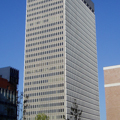There are four skyscrapers shoehorned onto this block that has been reconfigured to accommodate the latest: 3 PNC Plaza (2007–2009, Gensler, with Astorino Architects), a green design with two inter-locking structures of differing height and surface treatment that contains a hotel, condominiums, and retail and office space in its twenty-three stories. Luckily Skidmore, Owings and Merrill (SOM) minimized the bulk of its 2 PNC Plaza (1974, Natalie DeBlois for SOM) by creating two skewed thirty-four-story, octagonal towers of reflective glass, which nicely complement the squared orientation of the adjacent thirty-story 1 PNC Plaza tower (1972, Welton Becket and Associates). DeBlois's participation made 2 PNC Plaza (formerly the Equibank Building) the world's largest designed by a woman at that time. The fourth skyscraper at 210 6th Avenue is the tallest (at thirty-nine stories) and was built first (1968, William Lescaze and Associates). While it has had a variety of owners over the years, the rectangular, wine-red high-rise has retained two colorful ceramic murals (neither of which is now visible), one by Pierre Soulages in the north lobby and the other by Virgil D. Cantini in the south lobby.
You are here
PNC Plaza and 210 6th Avenue
If SAH Archipedia has been useful to you, please consider supporting it.
SAH Archipedia tells the story of the United States through its buildings, landscapes, and cities. This freely available resource empowers the public with authoritative knowledge that deepens their understanding and appreciation of the built environment. But the Society of Architectural Historians, which created SAH Archipedia with University of Virginia Press, needs your support to maintain the high-caliber research, writing, photography, cartography, editing, design, and programming that make SAH Archipedia a trusted online resource available to all who value the history of place, heritage tourism, and learning.













